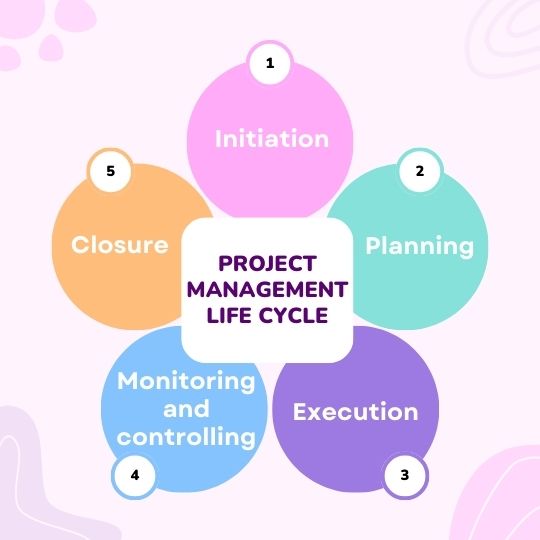Introduction to Project Management Life Cycle.
In this article we will go through the topic Project Management Life Cycle. The project Management Life Cycle is a series of phases that a project passes through from initiation to completion. Each phase has its own set of activities, deliverables, and objectives, and they are typically sequential but can sometimes overlap or iterate depending on the project’s nature and requirements. Understanding the project life cycle is crucial for effective project management as it provides a structured framework for planning, executing, and controlling projects. Let’s delve into the phases of the project management life cycle and related concepts:
The 5 basic phases in the Project Management Life Cycle are:
- Project Initiation
2. Project Planning
3. Project Execution
4. Project Monitoring and Controlling
5. Project Closure
1. Initiation Phase:
This phase marks the beginning of the project. It involves identifying the project’s purpose, goals, scope, and stakeholders. Key activities include conducting feasibility studies, defining objectives, and securing initial approvals. The initiation phase sets the foundation for the project and establishes the framework within which it will operate.
2. Planning Phase:
In this phase, project managers work on developing a comprehensive project plan. This includes defining tasks, estimating resources, creating schedules, setting budgets, and identifying potential risks. The project plan serves as a roadmap for guiding the project team throughout the execution phase. Effective planning is crucial for minimizing risks and ensuring the project’s success.
3. Execution Phase:
During the execution phase, the project plan is implemented, tasks are assigned, and progress is monitored to ensure alignment with project objectives. It’s a critical stage where the project moves from planning to action, with the project team actively working on delivering the planned outcomes. Project managers must monitor progress, manage changes, and resolve issues as they arise to keep the project on track.
4. Monitoring and Controlling Phase:
This phase involves tracking project performance, comparing it against the project plan, and implementing any necessary changes to keep the project on course. Key activities include collecting data, analyzing variances, assessing risks, and making adjustments as needed. Monitoring and controlling ensure that the project stays within scope, budget, and schedule, while also meeting quality standards.
5. Closure Phase:
The closing phase occurs when the project is completed or terminated. It involves finalizing all activities, delivering the project deliverables to the client or stakeholders, obtaining formal acceptance, and releasing project resources. Additionally, project closure includes conducting post-project reviews or lessons learned sessions to identify successes, challenges, and areas for improvement. Proper closure is essential for transitioning the project’s outcomes into operations or initiating follow-up actions.

Read Also: Project Organisation
Related Concepts of Project Management Life Cycle:
1. Work Breakdown Structure:
A Work Breakdown Structure (WBS) is like a roadmap for a project. It helps break down the big tasks into smaller, easier-to-handle pieces. This makes it easier to understand what needs to be done for the project. This hierarchical approach aids in the organization and comprehension of the necessary work for the projects.
2. Critical Path Method (CPM):
A project management technique used to determine the longest sequence of dependent tasks and identify the shortest possible duration for completing the project. It helps in scheduling activities efficiently.
3. Risk Management:
The process of identifying, assessing, and mitigating risks that could affect the project’s objectives. Risk management involves strategies for minimizing threats and maximizing opportunities throughout the project life cycle.
4. Stakeholder Management:
The process of identifying stakeholders, understanding their needs and expectations, and managing their engagement throughout the project. Effective stakeholder management is critical for ensuring their support and involvement in project activities.
5. Quality Management:
The process of ensuring that project deliverables meet the required standards and satisfy the stakeholders’ expectations. Quality management involves defining quality criteria, performing quality assurance activities, and addressing any defects or deviations from standards.
The project life cycle provides a structured approach to managing projects from start to finish. By understanding and effectively navigating through its phases, project managers can increase the likelihood of project success by delivering the intended outcomes within scope, schedule, budget, and quality constraints. Additionally, integrating related concepts such as WBS, CPM, risk management, stakeholder management, and quality management enhances the project management process and improves overall project performance.
These concepts are integral parts of the project management life cycle and are interconnected with its various phases:
Initiation Phase:
Stakeholder Management: During project initiation, identifying and engaging stakeholders is crucial to understand their expectations and gain their support for the project.
Risk Management: Initial risk identification and assessment are performed to understand potential obstacles and uncertainties that may impact the project’s success.
Planning Phase:
Work Breakdown Structure (WBS): In the planning phase, the WBS is developed to break down the project scope into manageable tasks, aiding in the creation of detailed project plans.
Critical Path Method (CPM): During planning, CPM is utilized to sequence activities and determine the critical path, which helps in creating realistic project schedules.
Execution Phase:
Stakeholder Management: Continuously engaging stakeholders during execution ensures their ongoing support and alignment with project goals.
Quality Management: Executing quality assurance processes ensures that project deliverables meet the defined quality standards.
Monitoring and Controlling Phase:
Risk Management: Risk monitoring and control activities are performed to track identified risks and implement mitigation strategies as needed to keep the project on track.
Critical Path Method (CPM): Monitoring the critical path helps in identifying any deviations from the planned schedule and taking corrective actions to minimize delays.
Closure Phase:
Quality Management: Final quality checks are conducted to ensure that all project deliverables meet the specified quality criteria before formally closing the project.
Stakeholder Management: Closing activities may involve obtaining formal acceptance from stakeholders and ensuring their satisfaction with the project outcomes.
Conclusion to Project Management Life Cycle:
In the intricate dance of project management, each phase of the life cycle plays a vital role, weaving together strategy, execution, and evaluation. From initiation’s spark of idea to planning’s meticulous blueprint, and through execution’s flurry of activity, every step forward is a testament to collaboration and dedication. As milestones are reached and hurdles overcome, the project takes shape, guided by the compass of risk management and the steady hand of leadership. And in the final moments, as the project draws to a close, reflections on lessons learned pave the way for future endeavors, ensuring that each cycle perpetuates growth and excellence. These concepts are integrated into each phase of the project management life cycle, contributing to the overall success of the project. They help in effectively managing project scope, schedule, resources, risks, stakeholders, and quality throughout the project’s journey from initiation to closure.


One thought on “What is Project Management Life Cycle”